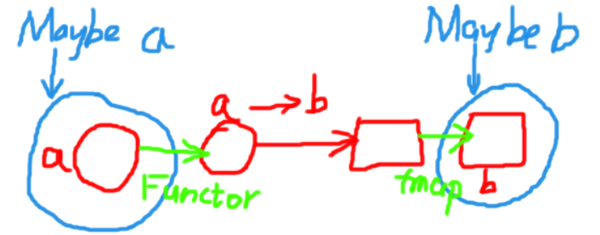Haskell初学指南
使用包管理器cabal安装Happy
# 编译安装
cabal get happy && cd happy* && cabal configure && cabal install
# 直接从Hackage安装,--ghc-options="+RTS -M200M" -j1的flag
# 是为了防止并行编译使用过多内存导致内存耗尽,如果内存很大
# 可以去掉。安装Haskell库时要加-lib,用cabal安装二进制程序
# 时不需要加-lib的参数
cabal install happy --ghc-options="+RTS -M200M" -j1如何在GHCi查看包内的所有函数的签名?
import Data.List
:browse Data.Listimport as ?
import qualified Data.Map as Map 如何查看类型,类别(Kinds: types of types),帮助信息?
:t []
:kind Monad
:i Monad实现两参数函数f的Partial application
elem :: Eq a => a -> t a -> Bool
-- 判断数字是否在列表[1..4]中
isInList :: Int -> Bool
isInList = (`elem` [1..4])
-- 判断4是否在列表中
hasElem :: [Int] -> Bool
hasElem = elem 4实现Bool类型的异或
{-# LANGUAGE FlexibleInstances #-}
class CanXOR a where
xor :: a -> a -> a
instance CanXOR [Bool] where
xor a b = map (\(x,y)->x /= y) (zip a b)
instance CanXOR Bool where
xor a b = a/=b列表推导
import Data.List
[(x, y, a) | x <- [1 .. 10], y <- [2..5], even (x+y), let a = 3]
perms [] = [[]]
perms xs = [ x:ps | x <- xs , ps <- perms ( xs\\[x] ) ]从标准输入中读取整数数组并输出
main = do
s <- getLine
let nums = map (\x -> read x::Int) $ words s
print nums使用lambda代数实现where
sumSquareOrSquareSum x y = if sumSquare > squareSum
then sumSquare
else squareSum
where sumSquare = x^2 + y^2
squareSum = (x+y)^2
-- 两个函数等价
sumSquareOrSquareSum x y = (\sumSquare squareSum ->
if sumSquare > squareSum
then sumSquare
else squareSum) (x^2 + y^2) ((x+y)^2)使用lambda代数实现let
overwrite x = let x = 2
in
let x = 3
in
let x = 4
in
x
-- 两个函数等价
overwrite x = (\x ->
(\x ->
(\x -> x) 4
)3
)2使用lambda代数实现变量覆盖(覆盖x)
-- lambda表达式(\x->content)中content里的x会被覆盖
add4 x = (\x->(\x->(\x->x+1) x +1) x +1) xGCD
gcd a 0 = a
gcd a b = gcd b (mod a b)实现take
myTake 0 x = []
myTake n [] = []
myTake n (x:xs) = x:(myTake (n-1) xs)实现drop
myDrop 0 (x:xs) = xs
myDrop n [] = []
myDrop n (x:xs) = x:(myDrop (n-1) xs)实现reverse
myReverse [] = []
myReverse (x:xs) = (myReverse xs) ++ [x]两种方法实现Fibonacci数列
--调用栈过深的算法(很慢)
fib 0 = 0
fib 1 = 1
fib n = fib (n-1) + fib (n-2)
--更快的算法
fastFib n1 n2 1 = n2
fastFib n1 n2 counter = fastFib n2 (n1+n2) (counter-1)实现和filter相反的remove
remove test x = filter (\e->(not (test e))) x判断是否是回文
isPalindrome x = y == (reverse y) where y= filter (\e->e/=' ') (map toLower x)
-- isPalindrome "A man a plan a canal Panama" -> True计算调和级数
harmonic n= foldl (\x y->x+1/y) 0 [1..n]实现对象和类
-- obj类保存一个数字
obj num = \get -> get num
-- 使用getNum方法获取对象保存的数字
getNum ins = ins id
-- subtractByN方法会改变对象的状态
subtractByN ins n = obj ( (getNum ins) - n)
-- 使用isNeg方法检查数据是否小于0
isNeg ins = (getNum ins) < 0使用Record Syntax 创建新的Robot类型
data Robot = Robot {
name :: Name,
attack :: Attack,
hp :: HP } 更新名为r的Record中的属性值
setAttack r newAttack = r { attack=newAttack}实现非Enum类型类的succ函数
cycleSucc :: (Bounded a, Enum a, Eq a) => a -> a
cycleSucc n = if n == maxBound then minBound else succ n实现骰子类型
data SixSidedDie = S1 | S2 | S3 | S4 | S5 | S6 deriving (Eq,Ord, Enum )
instance Show SixSidedDie where
show S1 = "one"
show S2 = "two"
show S3 = "three"
show S4 = "four"
show S5 = "five"
show S6 = "six"按元组第2个元素排序
data Name = Name (String, String) deriving (Show, Eq)
instance Ord Name where
compare (Name (f1,l1)) (Name (f2,l2)) = compare (l1,f1) (l2,f2)使用Data.Semigroup和guard实现颜色加法幺半群
data Color = Red |
Yellow |
Blue |
Green |
Purple |
Orange |
Brown |
Clear deriving (Show,Eq)
instance Semigroup Color where
(<>) Clear any = any
(<>) any Clear = any
(<>) a b | a == b = a
| all (`elem` [Red,Blue,Purple]) [a,b] = Purple
| all (`elem` [Blue,Yellow,Green]) [a,b] = Green
| all (`elem` [Red,Yellow,Orange]) [a,b] = Orange
| otherwise = Brown
instance Monoid Color where
mempty = Clear
mappend = (<>)从标准输入读取3行并输出
main :: IO ()
main = do
vals <- mapM (\_ -> getLine) [1..3]
mapM_ putStrLn vals从命令行参数接收行数n,从标准输入接收n行数字并求和
-- Filename: sum.hs --
import System.Environment
import Control.Monad
main :: IO ()
main = do
args <- getArgs
let linesToRead = if length args > 0
then read (head args)
else 0 :: Int
numbers <- replicateM linesToRead getLine
let ints = map read numbers :: [Int]
print (sum ints)
-- 使用惰性求值可以更好地处理
-- Filename: sum_lazy.hs
toInts :: String -> [Int]
toInts = map read . lines
main :: IO ()
main = do
userInput <- getContents
let numbers = toInts userInput
print (sum numbers)Functor,Applicative,和Monad图示

Functor
Functor类型类中最重要的函数是fmap,类型签名是fmap :: (a -> b) -> f a -> f b,如果把f换成Maybe,那么正是上图表示的功能,它可以接受一个a->b的函数和一个在Maybe上下文中的a类型,输出在Maybe上下文中的b类型。
例子:
fmap (+1) (Just 1) -- Output: Just 2
(+1) <$> (Just 1) -- Output: Just 2
fmap (+1) Nothing -- Output: Nothing
(+1) <$> Nothing -- Output: Nothing
show <$> (Just 1) -- Output: Just "1"
Applicative
Applicative类型类中最重要的函数是pure :: a -> f a和(<*>) :: f (a -> b) -> f a -> f b。
pure可以通过将函数Maybe a -> b和pure:: b -> Maybe b复合,得到Maybe a->Maybe b的函数。
<*>可以接受在Maybe上下文的a和在Maybe上下文中的a->b类型函数(函数可能不存在),输出Maybe上下文中的b。
例子:
sum3 :: Int -> Int -> Int -> Int
sum3 x y z = x+y+z
-- 这一步只能用fmap(<$>)
sumFunctor :: Maybe (Int -> Int -> Int)
sumFunctor = sum3 <$> (Just 1)
-- 这一步只能用(<*>)
sumApplicative :: Maybe (Int -> Int)
sumApplicative = sumFunctor <*> (Just 2)
-- 总结一下:在Maybe context下对多个参数的pure函数传参可以简单地写成:
sum3 <$> (Just 1) <*> (Just 2) <*> (Just 3)
-- 等价的写法
pure sum3 <*> (Just 1) <*> (Just 2) <*> (Just 3)
-- 列表也是一个context
-- 两个列表中元素两两相加
pure (+) <*> [1..4] <*> [4..7]
-- 笛卡尔积
pure (*) <*> [1..4] <*> [4..7]
-- 构建2元组
pure (,) <*> [1..4] <*> [4..7]
Monad
Monad类型类中最重要的函数是(>>=) :: m a -> (a -> m b) -> m b。此类型签名与上图几乎完全一样,m对应Maybe。
评论已关闭